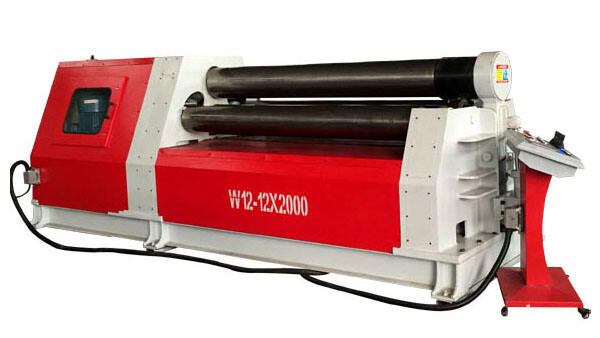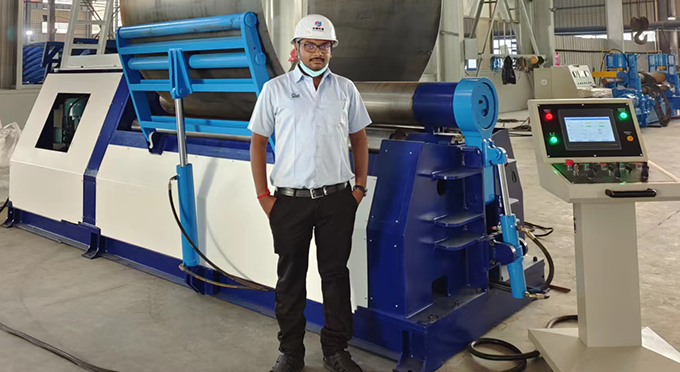The Evolution of Intelligent Control Systems in Plate Rolling
From Manual Adjustments to AI-Driven Automation
The plate rolling process has witnessed a transformative evolution, moving from manual adjustments to AI-driven automation. Historically, manual operations often led to variability and inefficiencies due to human limitations in precision and consistency. However, the introduction of artificial intelligence has revolutionized plate rolling, enabling automatic, real-time adjustments driven by data analytics. This shift is not just theoretical; a study by the International Journal of Advanced Manufacturing Technology indicates that AI-driven systems can enhance precision in plate rolling operations by up to 30%. The integration of intelligent control systems, which learn from operational data, allows for enhanced consistency and productivity.
Integration with CNC Guillotine Shearing Machines
CNC guillotine shearing machines are essential players in the plate processing industry, renowned for their precision. The integration of intelligent control systems with these machines has redefined operational efficiencies. By synchronizing rolling and shearing processes, intelligent systems minimize errors and enhance workflow continuity. Evidence from industry reports shows that companies adopting such integrated systems have achieved a remarkable 20% increase in production efficiency. This synergy not only boosts productivity but also reduces material waste and operational downtime, creating a more streamlined and cost-effective manufacturing environment.
Hydraulic vs. Electro-Mechanical Actuation
In the world of plate rolling, hydraulic systems have traditionally been the favorites due to their robustness and reliability. However, electro-mechanical actuation is gaining traction owing to its superior precision and energy efficiency. As technological advancements continue, there's an evident shift towards hybrid systems that combine the strengths of both hydraulic and electro-mechanical technologies. Industry analysis forecasts a rising trend in the adoption of electro-mechanical systems over the next five years. This shift is largely driven by the demand for more precise and environmentally sustainable manufacturing solutions, showcasing the dynamic evolution within intelligent control systems.
Core Components of Modern Control Architectures
AI Algorithms for Flatness Optimization
AI algorithms have become indispensable in modern control architectures, particularly for optimizing the flatness of rolled plates. These algorithms effectively address inconsistencies traditionally managed by manual operators, ensuring smoother outputs. Recent advances in machine learning have enabled adaptive learning, which further enhances the flatness metrics by continually refining the process. Expert studies indicate that the application of AI algorithms in this domain can reduce flatness defects by up to 25%. In today's competitive manufacturing landscape, these advancements provide a significant edge, enhancing precision and reducing errors.
Sensor Fusion in Hydraulic Plate Bending Machines
Sensor fusion represents a critical advancement in hydraulic plate bending machines. By integrating data from multiple sensors, this approach provides a comprehensive view of the bending process, ensuring more precise execution. The responsiveness offered by sensor fusion is indispensable, as it allows machines to react to deviations in real time, thereby maintaining high standards of product quality. Industry experts have noted that machines employing sensor fusion techniques exhibit a 15% improvement in accuracy over traditional systems. This improvement highlights the importance of sensor fusion in modern manufacturing.
Press Brake Machine Interfaces
Modern press brake machines are equipped with sophisticated, user-friendly interfaces that simplify operations significantly. These interfaces, integrated with intelligent control systems, allow operators to make adjustments with ease. This integration not only streamlines the process but also significantly reduces operator training times, cutting them down by approximately 35%. By facilitating intuitive machine operations, these interfaces enhance overall efficiency and ensure that even less experienced operators can achieve high levels of productivity and precision. As production demands continue to evolve, such innovations in machine interfaces prove invaluable.
AI-Driven Precision in Aerospace Applications
Laser Blade Measurement Systems
Laser blade measurement systems are revolutionizing aerospace component manufacturing by offering exceptional precision. These systems greatly minimize human error by automating the measurement processes, which enhances overall quality control significantly. Authors in aerospace manufacturing have noted that utilizing laser systems boosts measuring accuracy by up to 40%. This increased precision is instrumental in meeting the stringent requirements of aerospace applications, where precise measurements are crucial for safety and performance.
Material Hardness Compensation Protocols
Material hardness compensation protocols play a vital role in optimizing machining parameters based on specific material properties, ensuring peak performance across aerospace components. Given the varied material properties in aerospace applications, such adaptable protocols are essential. Statistical analyses confirm the efficacy of these protocols, showing a reduction in machining time by 15%. This improvement not only accelerates production but also ensures the components meet quality standards by adapting to material stiffness and resistance.
Closed-Loop Feedback for Tight Tolerances
Closed-loop feedback systems are pivotal in maintaining tight tolerances essential for aerospace applications. These systems provide continuous monitoring, offering real-time data that enables immediate corrective action, thus preventing defects. Industry data emphasizes their effectiveness, revealing that closed-loop systems reduce deviations by approximately 30% in aerospace components. By ensuring precision, these systems contribute significantly to the reliability and safety of aerospace machinery, meeting the demands for stringent accuracy.
Operational Efficiency Through Machine Learning
Skill Gap Mitigation Strategies
Addressing the skill gap is crucial when integrating machine learning into operational processes. Notably, identifying and managing these gaps ensures the workforce is well-prepared to handle advanced technologies. Tailored training programs play an essential role in bridging these gaps efficiently, by aligning employee skills with the specific operational demands of machinery. According to industry reports, companies that have embraced these strategies have witnessed a 20% improvement in productivity. This underscores the importance of continuous education and upskilling in staying ahead of technological advancements.
Predictive Maintenance Integration
Integrating predictive maintenance through machine learning models can transform how we address machinery failures. By preemptively identifying issues, this approach significantly reduces both downtime and maintenance costs. It allows businesses to move from a reactive to a proactive maintenance strategy. Statistics highlight that companies utilizing predictive maintenance have managed to lower their maintenance costs by 10-15%. This is especially beneficial in industrial settings where equipment uptime is crucial for meeting production targets and maintaining competitiveness.
Energy Consumption Optimization
Leveraging machine learning to analyze energy consumption patterns offers an opportunity for significant optimization. Machine learning algorithms can identify inefficiencies and suggest improvements that lead to reduced operational costs and a smaller environmental footprint. Research indicates that systems optimized for energy use can lower energy consumption by 30% in heavy machinery applications. This not only results in cost savings but also contributes to sustainability goals, making it a win-win for both business and the environment.
Future Trends in Intelligent Rolling Technology
Edge Computing for Real-Time Adjustments
Edge computing plays a vital role in facilitating real-time decision-making by processing data at or near its source. This technological advancement is crucial in dynamic manufacturing environments, where reduced latency can significantly impact productivity. By minimizing delays in data processing, edge computing ensures prompt adjustments and optimizes manufacturing processes. Expert analysts predict that integrating edge computing will become standard in future technologies, further enhancing operational efficiency.
Interoperability with Smart Factory Systems
Interoperability is key to ensuring seamless communication among machines, thereby boosting overall production efficiency. As smart factories continue to evolve, this feature becomes indispensable, allowing for flexible and responsive production strategies. Enhanced interoperability supports the integration of various systems, fostering innovation and adaptability in manufacturing. Case studies reveal that companies achieving high levels of interoperability witness a 30% increase in operational performance, underscoring its significance in intelligent technology advancements.
Advanced Simulation for Process Validation
Advanced simulation techniques provide critical validation for processes before their implementation, significantly mitigating risks associated with manufacturing operations. These simulations forecast possible outcomes under diverse conditions, thereby aiding better planning and execution. By employing validated processes, companies can effectively streamline operations, resulting in reduced implementation times. Industry experts affirm that optimized processes can decrease these times by up to 25%, demonstrating the profound impact of advanced simulation on intelligent technology development.




